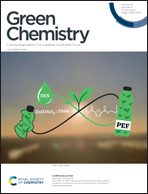Hydrogen-bonding and acid cooperative catalysis for benzylation of arenes with benzyl alcohols over ionic liquids†
Abstract
Herein, we for the first time report a hydrogen-bonding and acid cooperative catalysis strategy for the benzylation of arenes with benzyl alcohols over Brønsted acid ionic liquids (ILs, e.g., 1-propylsulfonate-3-methylimidazolium trifluoromethanesulfonate, [SO3H-PMIm][OTf]). [SO3H-PMIm][OTf] shows much better performance than acid catalysts (e.g., triflic acid, H2SO4), and is tolerant to a wide range of benzyl alcohols, affording various diarylmethanes in good to excellent yields, with some chemicals that are difficult to access. It was discovered that the IL cation activates benzyl alcohol to form a benzyl cation via acid and/or hydrogen-bonding catalysis, and the anion as a hydrogen bond acceptor activates the C–H bond in the benzene ring of arenes, which cooperatively realizes the benzylation of arenes to access diarylmethanes. Notably, the unique phase behavior of the reaction system makes the reaction proceed at the interfaces between the IL-based phase and the arene-based phase, and the IL spontaneously separates after the reaction. This simple, metal-free and green protocol has great potential for application in industry.



 Please wait while we load your content...
Please wait while we load your content...